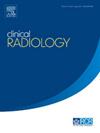A nomogram-based survival prediction model for non–small cell lung cancer patients based on clinical risk factors and multiregion radiomics features
IF 2.1
3区 医学
Q2 RADIOLOGY, NUCLEAR MEDICINE & MEDICAL IMAGING
引用次数: 0
Abstract
Aim
This study focuses on developing a nomogram-based overall survival (OS) prediction model for non–small cell lung cancer (NSCLC) patients by integrating clinical factors with multiregion radiomics features extracted from pretreatment CT images. The proposed nomogram aims to assist clinicians in stratifying patients into high- and low-risk groups for personalised treatment strategies.
Materials and Methods
From 2008 to 2018, 77 NSCLC patients were included. The radiomics feature was extracted from the internal and peripheral tumour region of pretreatment computed tomography (CT) images. The least absolute shrinkage and selection operator (LASSO) and the univariable Cox regression model were used to select the radiomics features. The Rad-score was defined as a linear combination of the selected radiomics features and the Cox proportional hazards regression coefficients. The combined model was constructed based on the clinicopathological factors and the Rad-score. The discrimination capacity of the prediction model was evaluated by Harrell's concordance index (C-index), the calibration curve, and the Kaplan–Meier survival curve.
Results
We found that nine radiomics features and histology were independent predictors. The combined model showed the best performance (C-index: 0.799 [95% CI: 0.726–0.872]) compared with the clinical model (C-index: 0.692 [95% CI: 0.625–0.759]) and Rad-score (C-index: 0.663 [95% CI: 0.580–0.746]), and could significantly stratify into high-risk and low-risk NSCLC patients. The calibration curve also showed good consistency between the observation and the prediction.
Conclusions
The multregion radiomics features have the potential for predicting OS in NSCLC patients. The nomogram-based survival prediction model demonstrates significant potential in guiding clinical decision-making, allowing for precise and personalised treatment for NSCLC patients.
基于临床风险因素和多区域放射组学特征的非小细胞肺癌患者生存预测模型
本文章由计算机程序翻译,如有差异,请以英文原文为准。
求助全文
约1分钟内获得全文
求助全文
来源期刊

Clinical radiology
医学-核医学
CiteScore
4.70
自引率
3.80%
发文量
528
审稿时长
76 days
期刊介绍:
Clinical Radiology is published by Elsevier on behalf of The Royal College of Radiologists. Clinical Radiology is an International Journal bringing you original research, editorials and review articles on all aspects of diagnostic imaging, including:
• Computed tomography
• Magnetic resonance imaging
• Ultrasonography
• Digital radiology
• Interventional radiology
• Radiography
• Nuclear medicine
Papers on radiological protection, quality assurance, audit in radiology and matters relating to radiological training and education are also included. In addition, each issue contains correspondence, book reviews and notices of forthcoming events.
 求助内容:
求助内容: 应助结果提醒方式:
应助结果提醒方式:


